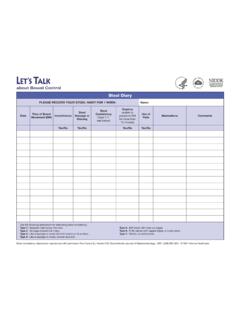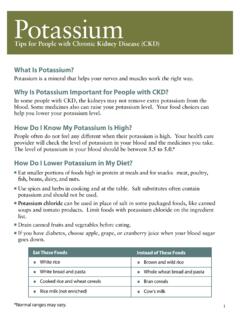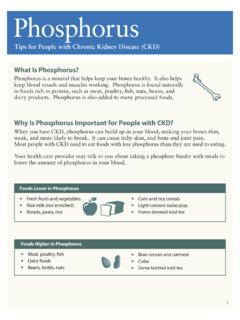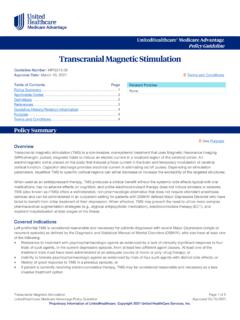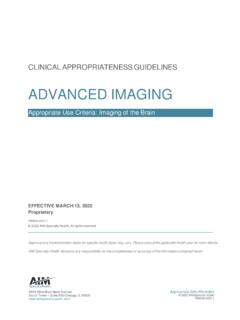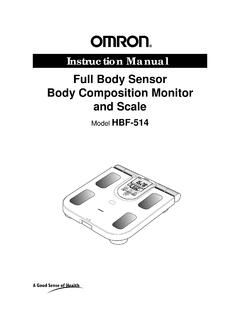Transcription of Diabetes Insipidus
1 Diabetes Insipidus National Kidney and Urologic Diseases Information Clearinghouse Department of Health and Human Services NATIONAL INSTITUTES OF HEALTH What is Diabetes Insipidus ? Diabetes Insipidus (DI) is a rare disease that causes frequent urination. The large volume of urine is diluted, mostly water. To make up for lost water, a person with DI may feel the need to drink large amounts and is likely to urinate frequently, even at night, which can disrupt sleep and, on occa sion, cause bedwetting. Because of the excretion of abnormally large volumes of dilute urine, people with DI may quickly become dehydrated if they do not drink enough water. Children with DI may be irritable or listless and may have fever, vomiting, or diarrhea.
2 Milder forms of DI can be managed by drinking enough water, usually between 2 and liters a day. DI severe enough to endanger a person s health is rare. What is the difference between Diabetes Insipidus and Diabetes mellitus? DI should not be confused with Diabetes mellitus (DM), which results from insulin deficiency or resistance leading to high blood glucose, also called blood sugar. DI and DM are unrelated, although they can have similar signs and symptoms, like exces sive thirst and excessive urination. DM is far more common than DI and receives more news coverage. DM has two main forms, type 1 Diabetes and type 2 Diabetes . DI is a different form of illness altogether. How is fluid in the body normally regulated?
3 The body has a complex system for balanc ing the volume and composition of body fluids. The kidneys remove extra body flu ids from the bloodstream. These fluids are stored in the bladder as urine. If the fluid regulation system is working properly, the kidneys make less urine to conserve fluid when water intake is decreased or water is lost, for example, through sweating or diar rhea. The kidneys also make less urine at night when the body s metabolic processes are slower. Hypothalamus The hypothalamus makes antidiuretic hormone (ADH), which directs the kidneys to make less urine. To keep the volume and composition of body fluids balanced, the rate of fluid intake is governed by thirst, and the rate of excretion is governed by the production of antidiuretic hormone (ADH), also called vasopressin.
4 This hormone is made in the hypothalamus, a small gland located in the brain. ADH is stored in the nearby pituitary gland and released into the bloodstream when necessary. When ADH reaches the kidneys, it directs them to concentrate the urine by reabsorbing some of the filtered water to the bloodstream and therefore make less urine. DI occurs when this precise system for regulating the kidneys handling of fluids is disrupted. What are the types of Diabetes Insipidus ? Central DI The most common form of serious DI, central DI, results from damage to the pitu itary gland, which disrupts the normal stor age and release of ADH. Damage to the pituitary gland can be caused by different diseases as well as by head injuries, neuro surgery, or genetic disorders.
5 To treat the ADH deficiency that results from any kind of damage to the hypothalamus or pituitary, a synthetic hormone called desmopressin can be taken by an injection, a nasal spray, or a pill. While taking desmopressin, a person should drink fluids only when thirsty and not at other times. The drug prevents water excretion, and water can build up now that the kidneys are making less urine and are less responsive to changes in body fluids. Nephrogenic DI Nephrogenic DI results when the kid neys are unable to respond to ADH. The kidneys ability to respond to ADH can be impaired by drugs like lithium, for example and by chronic disorders includ ing polycystic kidney disease, sickle cell disease, kidney failure, partial blockage of the ureters, and inherited genetic disorders.
6 Sometimes the cause of nephrogenic DI is never discovered. Desmopressin will not work for this form of DI. Instead, a person with nephrogenic DI may be given hydrochlorothiazide (HCTZ) or indomethacin. HCTZ is sometimes com bined with another drug called amiloride. The combination of HCTZ and amiloride is sold under the brand name Moduretic. Again, with this combination of drugs, one should drink fluids only when thirsty and not at other times. Dipsogenic DI Dipsogenic DI is caused by a defect in or damage to the thirst mechanism, which is located in the hypothalamus. This defect results in an abnormal increase in thirst and fluid intake that suppresses ADH secretion and increases urine output. Desmopressin or other drugs should not be used to treat dipsogenic DI because they may decrease urine output but not thirst and fluid intake.
7 This fluid overload can lead to water intoxi cation, a condition that lowers the con centration of sodium in the blood and can seriously damage the brain. Scientists have not yet found an effective treatment for dipsogenic DI. Diabetes Insipidus 2 Gestational DI Gestational DI occurs only during pregnancy and results when an enzyme made by the placenta destroys ADH in the mother. The placenta is the system of blood vessels and other tissue that develops with the fetus. The placenta allows exchange of nutrients and waste products between mother and fetus. Most cases of gestational DI can be treated with desmopressin. In rare cases, however, an abnormality in the thirst mechanism causes gestational DI, and desmopressin should not be used.
8 How is Diabetes Insipidus diagnosed? Because DM is more common and because DM and DI have similar symptoms, a health care provider may suspect that a patient with DI has DM. But testing should make the diagnosis clear. A doctor must determine which type of DI is involved before proper treatment can begin. Diagnosis is based on a series of tests, including urinalysis and a fluid depri vation test. Urinalysis is the physical and chemi cal examination of urine. The urine of a person with DI will be less concentrated. Therefore, the salt and waste concentra tions are low and the amount of water excreted is high. A physician evaluates the concentration of urine by measuring how many particles are in a kilogram of water or by comparing the weight of the urine with an equal volume of distilled water.
9 A fluid deprivation test helps determine whether DI is caused by one of the following: excessive intake of fluid a defect in ADH production a defect in the kidneys response to ADH This test measures changes in body weight, urine output, and urine composition when fluids are withheld. Sometimes measuring blood levels of ADH during this test is also necessary. In some patients, a magnetic resonance imaging (MRI) of the brain may be neces sary as well. Points to Remember Diabetes Insipidus (DI) is a rare dis ease that causes frequent urination and excessive thirst. DI is not related to Diabetes mellitus (DM). Central DI is caused by damage to the pituitary gland and is treated with a synthetic hormone called desmopres sin, which prevents water excretion.
10 Nephrogenic DI is caused by drugs or kidney disease and is treated with hydrochlorothiazide (HCTZ), indo methacin, or a combination of HCTZ and amiloride. 3 Diabetes Insipidus Scientists have not yet discovered an effective treatment for dipsogenic DI, which is caused by a defect in the thirst mechanism. Most forms of gestational DI can be treated with desmopressin. A doctor must determine which type of DI is involved before proper treatment can begin. Hope through ResearchThe National Institute of Diabetes and Digestive and Kidney Diseases (NIDDK) conducts and supports research into many kinds of kidney disease, including Diabetes Insipidus . NIDDK-supported researchers are exploring the cellular and molecular mechanisms that control fluid regulation in the body.
